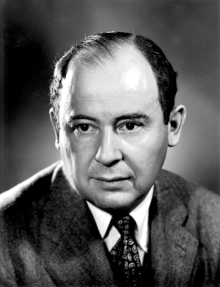Personna :: John von Neumann, the Legend!

John von Neumann (1903-1957) is a legendary figure in the history of mathematics, high-speed computing machines, the mathematical theory of games, economics, logic, quantum physics, and a number of other fields.
He was born in Budapest, Hungary, one of three sons in a well-to-do Jewish family. At a very early age it was clear that he had prodigious talents, such as his memory of phone numbers and addresses. He also had the ability to perform tremendous computations quickly and possessed the ability to divide two eight-digit numbers in his head.
By seventeen, he was dissuaded from studying mathematics by his father for financial reasons; this led to his obtaining a diploma in chemistry in Berlin (1921-1923) a diploma in Chemical Engineering from the Zurich Technical University (ETH) and a PhD in Mathematics from The University of Budapest (1926). He made contributions to set theory and logic in mathematics; however, some of his ideas were shaken by those of Kurt Godel.
He was a visiting lecturer at Princeton University in 1930 (at the age of 27), and by 1933 he helped found the Institute for Advanced Study where he was one of its six original professors in the School of Mathematics. von Neumann knew how to enjoy life in America; there were frequent parties at his home.
von Neumann produced over 150 papers, about 60 of them in pure mathematics, including set theory, logic, topological groups, measure theory, ergodic theory, operator theory, and continuous geometry. There were also about 20 papers in physics, and about 60 in applied mathematics, including statistics, game theory, and computer theory. In game theory, one of his early contributions was the theory of minimax, which led to his famous co-authored authoritative book on the subject with Oscar Morgenstern.
He is generally credited with designing the first computer architecture; his stored-program concept is the backbone for serial architectures to this day. He was interested in what machines could remember, questions of self-reproduction for automata, and the use of machines to perform a large number of probabilistic experiments.
Much of his greatness could be attributed to “…the extraordinary rapidity with which he could understand and think and the unusual memory that retained everything he had once thought through. “(Halmos, 1973).
Paul Halmos, the late esteemed mathematician, his student, and the author of an article, “The Legend of John von Neumann,” which formed much of the basis of our summary here, felt that it was von Neumann’s ability to stick to “axiomatic methods” that helped make him so great—his repeated clarity, speed, and depth of thought.
Reference ::
http://en.wikipedia.org/wiki/John_von_Neumann
Halmos, P. 1973.The legend of John von Neumann. The American Mathematical Monthly 80(4). http://www.jstor.org/stable/2319080 May 5, 2011
